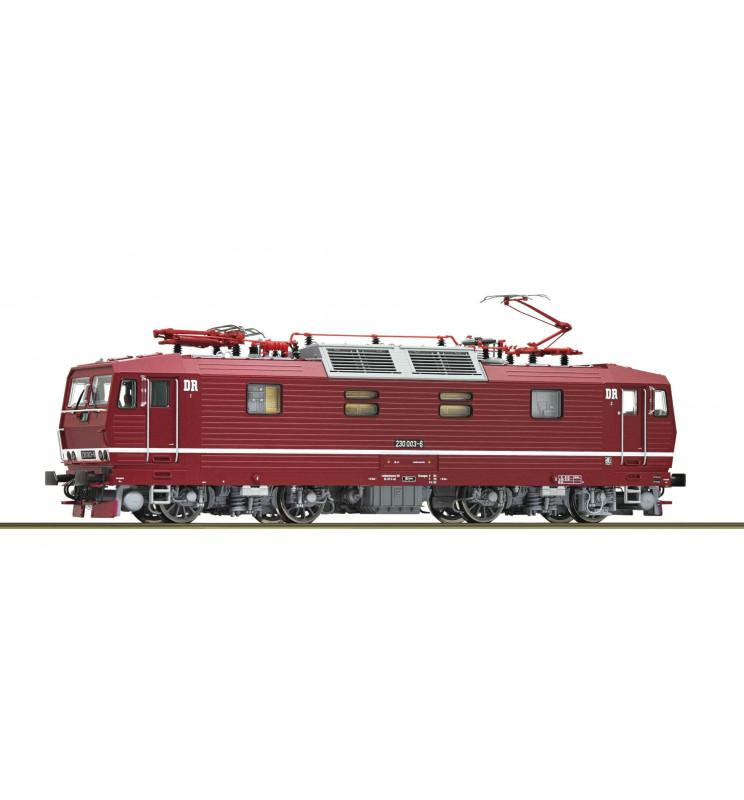


Roco 71220 - Elektrowóz BR 230 DR, ep. IV, DCC z dźwiękiem 16-bit
Nowość 2021
 Polityka bezpieczeństwa
Polityka bezpieczeństwa
(edytuj w module Customer Reassurance)
 Zasady dostawy
Zasady dostawy
(edytuj w module Customer Reassurance)
ROCO 71220
description: Electric locomotive class 230 railway company DR era 4
Completely new construction including 16-BIT SOUND for a perfect sound experience.
description/content: Version as a series locomotive of the class 230 Finely detailed model with many separately applied plug-in parts Completely newly-developed current collectors with innovative attachment Elaborate roof area design as well as the ventilator slats allowing an unobstructed view Delicate design of the bogies as well as the spoked wheels With rail guards and air tanks in closed form for realistic presentation in display cabinets Comprehensive lighting functions in the digital versions ex-works: Driver’s cab and control panel lighting as well as engine room lighting Rear signal can be switched using a DIP switch (analogue version) Newly-developed “Dynamic Sound” package with two loudspeakers for improved depth of sound Suitable for the D374/375 “Vindobona/Hungaria”, items 74188, 74189, 74190
information about prototype: The class 230 was the first dual-system locomotive used for the mainline service of what was then the Deutsche Reichsbahn (DR) in the GDR. The development, construction and testing of these locomotives took place as a collaborative, joint project between the DR and the Czechoslovakian State Railway (CSD). Due to a lack of experience in the field of dual-system technology (GDR: AC voltage 15 kV/16 2/3 Hz, CSSR: DC voltage 3 kV) and the full utilisation of capacities at the electric locomotive manufacturer LEW in Hennigsdorf, the engines were designed based on the CSD classes ES 499.1 and 499.2. However, the Škoda locomotive factory had never built an engine for the 15 kV/16 2/3 Hz AC system before, and for this reason the AC unit parts were supplied from the GDR, by LEW in Hennigsdorf. Due to the CSD’s requirements, this resulted in a two-fold contract for Škoda, with 20 locomotives for the DR (class 230) and 15 locomotives for the CSD (class 372). In 1988, one prototype was delivered for each railway; the 230 001 for the DR and the 372 001 for the CSD. Subsequent to the extensive testing program, series delivery of the other locomotives took place from 1991 onwards. These engines featured an hourly output of 3,260 kW and a maximum speed of 120 km/h. In 1992, the engines were renamed as BR 180 for the DB AG. The development of the Decín–Prague connection at a maximum speed of 160 km/h made it necessary to upgrade several locomotives. For this purpose, the CD converted six engines for express service, whilst the Deutsche Bahn only converted the 180 001. The special technical features and striking appearance of these locomotives ensured that railway employees rapidly developed nicknames for them. The BR 230/180 is lovingly known as the “Knödelpresse” (dumpling press). Its Czech counterpart was also given a nickname. In the neighbouring country, the class 372 is known as the “Bastard”, and the class 371 with its maximum speed of 160 km/h is called the “Turbobastard”. In the year 2014, the BR 180 run by DB Schenker Rail was slowly phased out as modern locomotives such as the BR 189 increasingly took over its services. In the first half-year of 2014, two locomotives underwent a general inspection, but on the other hand, ten of these engines were sold to the Czech Republic from the DB AG Shutdown Management Department. On 4th December 2014, the operation of the BR 180 in DB AG services came to an end. Some of the engines sold to the Czech private railway TSS Cargo with valid deployment periods were rapidly put into use again, and hauled cross-border goods trains to Bremerhaven, amongst other locations. This was a hitherto unthinkable field of operations. From 2016, the first locomotives were repainted in the yellow and blue colour scheme representing TSS. However, after a few runs on the Elbtal line and in the Czech Republic, the locomotives were soon withdrawn from service. The 180 014 is the only engine still preserved in German today as a museum piece by the Thuringia Railway Association.
electric system: DCC interface: Plux22
upgrated with decoder: yes function sound: ROCO Sound capacitor: yes
function light: yes light: LED light change: yes
additional light functions: Driverscab, engine lightning, drivers desk lightning
Lenghs over buffers: 193 minimum radius: R2
number of driven axles: 4 traction tires: 1 flywheel: yes
close coupling mechanism: yes
scale: 1:87 gauge H0
EAN number: 9005033712204
age rating: 14+ years